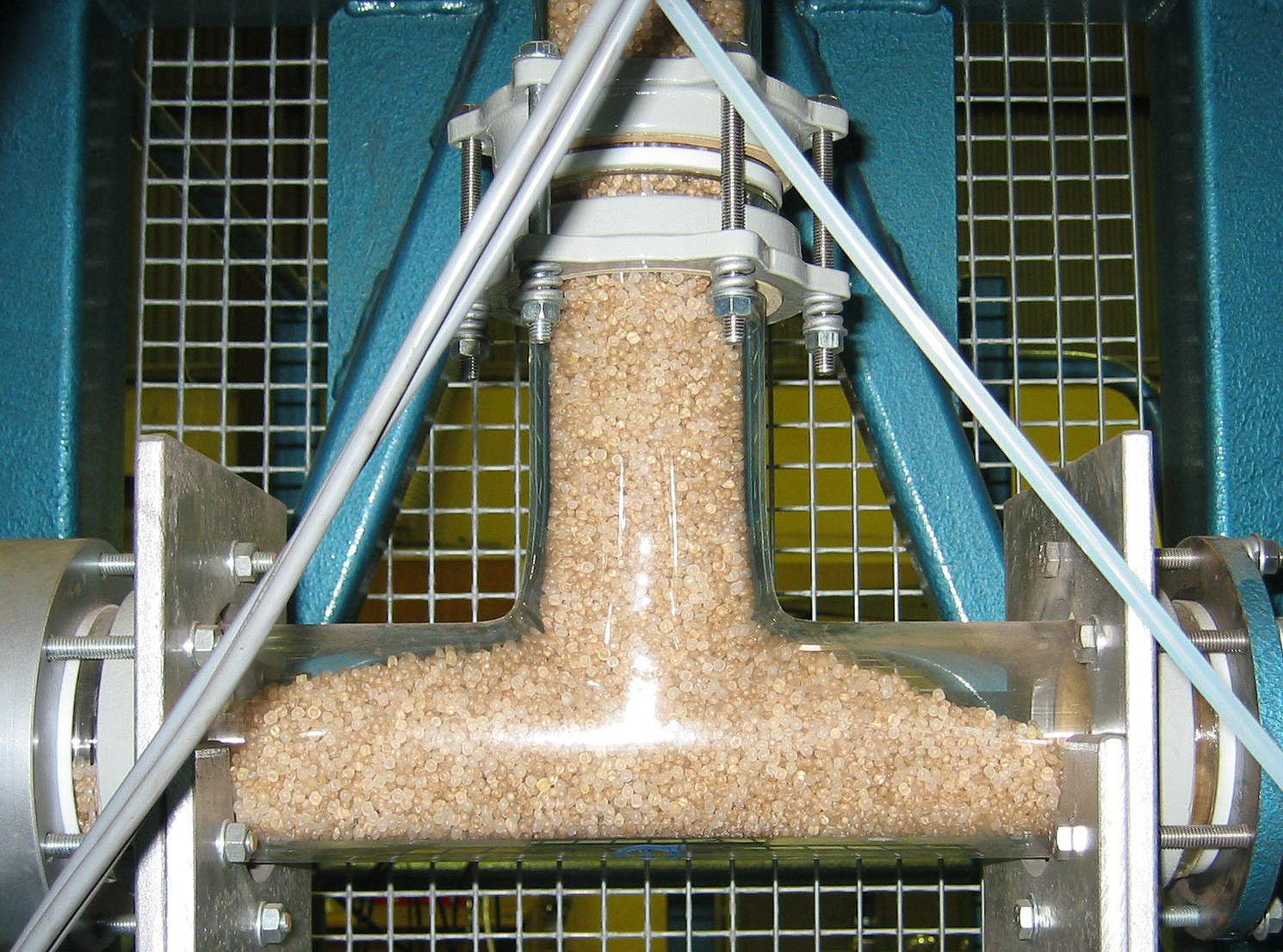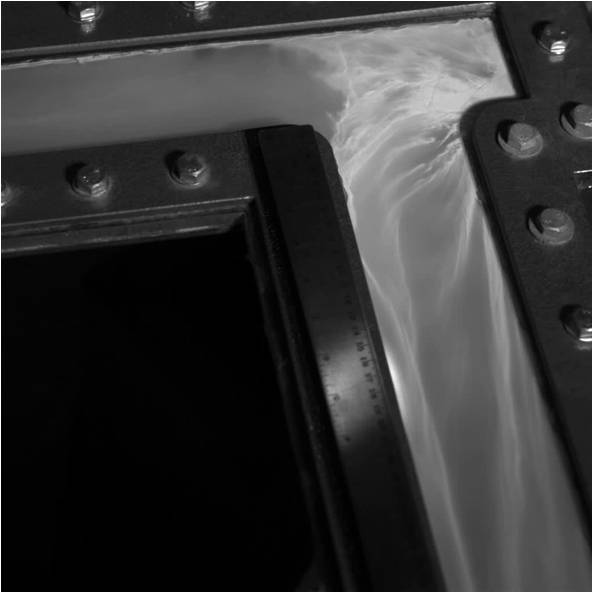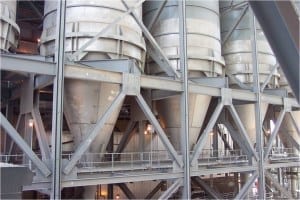Services List
-
Services By Handling Problems

Pneumatic Conveying Equipment and Testing Services
Aeration systems such as pneumatic conveyors, vertical lifters or air slides are dominated by the air-particle interactions within the pipeline, which are numerous depending on mode of flow.
In dilute or lean systems, this is dominated by lift, drag and collision forces. In dense particle laden flows, the air-particle interactions are much more complex and are largely dependent on the size distribution and density of the conveyed product.
TUNRA Bulk Solids offers the following design and testing services for pneumatic conveying systems:
Determination of Pneumatic Conveying Characteristics for New Design or Optimisation of Existing Systems
Pneumatic conveying characteristics include:
- Minimum and optimal conveying gas volume flow rate
- Optimal pipe diameter or diameters (for stepped pipelines)
- Solids to gas ratio and pressure gradient along the pipeline
This provides detailed information for optimal design of a conveying system to minimise energy use and pipeline wear in conjunction with appropriate choices for feeding, receiving and air-particle separation systems.
Scale-up of Existing Pneumatic Conveying Systems
The scale-up procedure takes into account process requirements such as solids mass flow rate, gas volume flow rate at pipe inlet, solids to gas ratio and pressure profile along the full length of the conveying pipeline system. Accurate scale-up requires prior determination of material conveying characterstics.

Selection of Appropriate Feeding and Separating Devices
The process requirements are reviewed for recommending feeding and/or separating device that will allow process optimisation.
Process Optimisation for Minimising Wear and Maximising Service Life Based on Wear
Optimal conveying flow mode is determined with respect to wear minimisation using either experimental testing or predictive methods. The service life of the pipeline, especially the bends, is determined to estimate replacement time for the pipeline and its components.
Minimum Transport Conditions
One of the primary steps for designing and optimising all particle-air transport systems is determining the minimum transport velocity required to lift and convey the material through the pipeline or channel.
This velocity as well as the steady-state flow conditions mainly depend on physical material characteristics such as density, bulk density, and flow mode. Initial characterisation of these velocities can be achieved through:
- Fluidisation and permeability testing
- Air-retention and de-aeration testing
- Vertical and horizontal minimum transport testing
Assessment of Probable Modes of Flow for Dense Phase Conveying
The procedure to determine the mode of flow likely to occur during pneumatic conveying of a given bulk material consists in two steps.
The first step consists of determining the key physical particle and bulk characteristics of the material influencing its aeration behaviour. This includes determination of particle size distribution, particle density, loose poured bulk density, compressibility and tapped bulk density, as well as permeability and aeration / de-aeration tests.
In a second step, predictive technique based on numerous flow charts is applied to determine the conveying mode of flow likely to occur.
- Flow Mode Visualisation:
The flow mode can be visualised utilising a pneumatic conveying rig whose conveying section entirely consists of glass. In addition, conveying tests can be carried out in an industrial-scale pneumatic conveying system including a pipe section made of glass to visualise the flow mode. A standard camera or high-speed video camera can be used to record the flow. - Full Scale Conveying Testing:
Full scale pneumatic conveying tests are offered in a range of pipe diameter from 2 inches (53 mm) to 4 inches (100 mm) up to total conveying length over 180 meters. The tests allow accurate determination of conveying characteristics such as conveying velocity, solids mass flow rate and pressure loss along pipe sections of different configurations, i.e. straight pipes and bends. Test results can be used to predict conveying parameters for transport along both short and long distance with great accuracy.

Wear Analysis
With most particle transport systems, the particle and wall interaction will produce some type of wear to the wall surface and potentially degrade the particulate material.
To characterise these processes, abrasive wear, erosive wear and particle attrition testing is available.
Wear test gives outputs of the best wall material to maximise service life and estimate life expectancy for each liner material tested.
Case Studies
The following case studies highlight a selection of pneumatic conveying projects completed by TUNRA Bulk Solids:
-
Services By Industry

Pneumatic Conveying Equipment and Testing Services
Aeration systems such as pneumatic conveyors, vertical lifters or air slides are dominated by the air-particle interactions within the pipeline, which are numerous depending on mode of flow.
In dilute or lean systems, this is dominated by lift, drag and collision forces. In dense particle laden flows, the air-particle interactions are much more complex and are largely dependent on the size distribution and density of the conveyed product.
TUNRA Bulk Solids offers the following design and testing services for pneumatic conveying systems:
Determination of Pneumatic Conveying Characteristics for New Design or Optimisation of Existing Systems
Pneumatic conveying characteristics include:
- Minimum and optimal conveying gas volume flow rate
- Optimal pipe diameter or diameters (for stepped pipelines)
- Solids to gas ratio and pressure gradient along the pipeline
This provides detailed information for optimal design of a conveying system to minimise energy use and pipeline wear in conjunction with appropriate choices for feeding, receiving and air-particle separation systems.
Scale-up of Existing Pneumatic Conveying Systems
The scale-up procedure takes into account process requirements such as solids mass flow rate, gas volume flow rate at pipe inlet, solids to gas ratio and pressure profile along the full length of the conveying pipeline system. Accurate scale-up requires prior determination of material conveying characterstics.

Selection of Appropriate Feeding and Separating Devices
The process requirements are reviewed for recommending feeding and/or separating device that will allow process optimisation.
Process Optimisation for Minimising Wear and Maximising Service Life Based on Wear
Optimal conveying flow mode is determined with respect to wear minimisation using either experimental testing or predictive methods. The service life of the pipeline, especially the bends, is determined to estimate replacement time for the pipeline and its components.
Minimum Transport Conditions
One of the primary steps for designing and optimising all particle-air transport systems is determining the minimum transport velocity required to lift and convey the material through the pipeline or channel.
This velocity as well as the steady-state flow conditions mainly depend on physical material characteristics such as density, bulk density, and flow mode. Initial characterisation of these velocities can be achieved through:
- Fluidisation and permeability testing
- Air-retention and de-aeration testing
- Vertical and horizontal minimum transport testing
Assessment of Probable Modes of Flow for Dense Phase Conveying
The procedure to determine the mode of flow likely to occur during pneumatic conveying of a given bulk material consists in two steps.
The first step consists of determining the key physical particle and bulk characteristics of the material influencing its aeration behaviour. This includes determination of particle size distribution, particle density, loose poured bulk density, compressibility and tapped bulk density, as well as permeability and aeration / de-aeration tests.
In a second step, predictive technique based on numerous flow charts is applied to determine the conveying mode of flow likely to occur.
- Flow Mode Visualisation:
The flow mode can be visualised utilising a pneumatic conveying rig whose conveying section entirely consists of glass. In addition, conveying tests can be carried out in an industrial-scale pneumatic conveying system including a pipe section made of glass to visualise the flow mode. A standard camera or high-speed video camera can be used to record the flow. - Full Scale Conveying Testing:
Full scale pneumatic conveying tests are offered in a range of pipe diameter from 2 inches (53 mm) to 4 inches (100 mm) up to total conveying length over 180 meters. The tests allow accurate determination of conveying characteristics such as conveying velocity, solids mass flow rate and pressure loss along pipe sections of different configurations, i.e. straight pipes and bends. Test results can be used to predict conveying parameters for transport along both short and long distance with great accuracy.

Wear Analysis
With most particle transport systems, the particle and wall interaction will produce some type of wear to the wall surface and potentially degrade the particulate material.
To characterise these processes, abrasive wear, erosive wear and particle attrition testing is available.
Wear test gives outputs of the best wall material to maximise service life and estimate life expectancy for each liner material tested.
Case Studies
The following case studies highlight a selection of pneumatic conveying projects completed by TUNRA Bulk Solids:
-
Services By Material Type

Pneumatic Conveying Equipment and Testing Services
Aeration systems such as pneumatic conveyors, vertical lifters or air slides are dominated by the air-particle interactions within the pipeline, which are numerous depending on mode of flow.
In dilute or lean systems, this is dominated by lift, drag and collision forces. In dense particle laden flows, the air-particle interactions are much more complex and are largely dependent on the size distribution and density of the conveyed product.
TUNRA Bulk Solids offers the following design and testing services for pneumatic conveying systems:
Determination of Pneumatic Conveying Characteristics for New Design or Optimisation of Existing Systems
Pneumatic conveying characteristics include:
- Minimum and optimal conveying gas volume flow rate
- Optimal pipe diameter or diameters (for stepped pipelines)
- Solids to gas ratio and pressure gradient along the pipeline
This provides detailed information for optimal design of a conveying system to minimise energy use and pipeline wear in conjunction with appropriate choices for feeding, receiving and air-particle separation systems.
Scale-up of Existing Pneumatic Conveying Systems
The scale-up procedure takes into account process requirements such as solids mass flow rate, gas volume flow rate at pipe inlet, solids to gas ratio and pressure profile along the full length of the conveying pipeline system. Accurate scale-up requires prior determination of material conveying characterstics.

Selection of Appropriate Feeding and Separating Devices
The process requirements are reviewed for recommending feeding and/or separating device that will allow process optimisation.
Process Optimisation for Minimising Wear and Maximising Service Life Based on Wear
Optimal conveying flow mode is determined with respect to wear minimisation using either experimental testing or predictive methods. The service life of the pipeline, especially the bends, is determined to estimate replacement time for the pipeline and its components.
Minimum Transport Conditions
One of the primary steps for designing and optimising all particle-air transport systems is determining the minimum transport velocity required to lift and convey the material through the pipeline or channel.
This velocity as well as the steady-state flow conditions mainly depend on physical material characteristics such as density, bulk density, and flow mode. Initial characterisation of these velocities can be achieved through:
- Fluidisation and permeability testing
- Air-retention and de-aeration testing
- Vertical and horizontal minimum transport testing
Assessment of Probable Modes of Flow for Dense Phase Conveying
The procedure to determine the mode of flow likely to occur during pneumatic conveying of a given bulk material consists in two steps.
The first step consists of determining the key physical particle and bulk characteristics of the material influencing its aeration behaviour. This includes determination of particle size distribution, particle density, loose poured bulk density, compressibility and tapped bulk density, as well as permeability and aeration / de-aeration tests.
In a second step, predictive technique based on numerous flow charts is applied to determine the conveying mode of flow likely to occur.
- Flow Mode Visualisation:
The flow mode can be visualised utilising a pneumatic conveying rig whose conveying section entirely consists of glass. In addition, conveying tests can be carried out in an industrial-scale pneumatic conveying system including a pipe section made of glass to visualise the flow mode. A standard camera or high-speed video camera can be used to record the flow. - Full Scale Conveying Testing:
Full scale pneumatic conveying tests are offered in a range of pipe diameter from 2 inches (53 mm) to 4 inches (100 mm) up to total conveying length over 180 meters. The tests allow accurate determination of conveying characteristics such as conveying velocity, solids mass flow rate and pressure loss along pipe sections of different configurations, i.e. straight pipes and bends. Test results can be used to predict conveying parameters for transport along both short and long distance with great accuracy.

Wear Analysis
With most particle transport systems, the particle and wall interaction will produce some type of wear to the wall surface and potentially degrade the particulate material.
To characterise these processes, abrasive wear, erosive wear and particle attrition testing is available.
Wear test gives outputs of the best wall material to maximise service life and estimate life expectancy for each liner material tested.
Case Studies
The following case studies highlight a selection of pneumatic conveying projects completed by TUNRA Bulk Solids:











